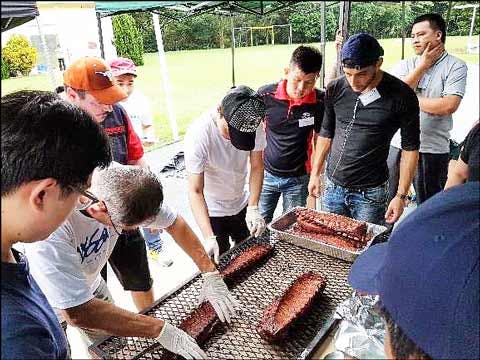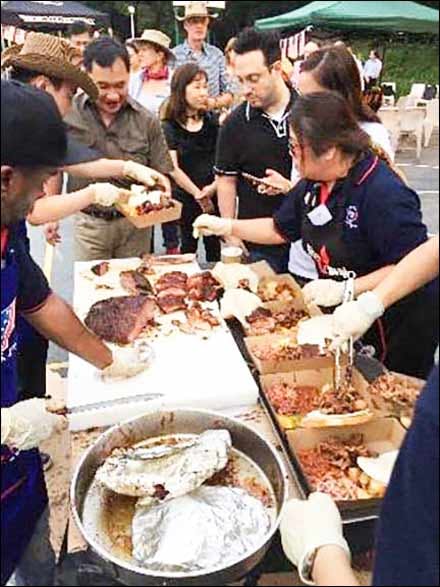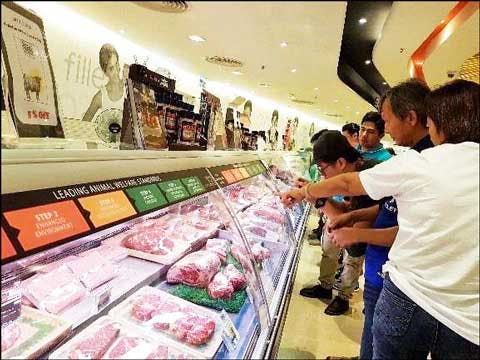Singapore Chefs Given Taste of Texas Barbecue
A team of chefs from Singapore hotels and restaurants visited Hong Kong for training on Texas barbecue and an educational program on the use of U.S. beef and pork. Funded by the USDA Market Access Program, the Texas Beef Council, the Beef Checkoff Program and the Pork Checkoff, the “U.S. Meat Culinary Barbecue Program” represented the first such venture for 16 participants selected by USMEF’s ASEAN office.

Chefs from Singapore get a lesson in Texas barbecue at a training and educational session organized by USMEF
Along with lessons on barbecue equipment and preparation of meat, the training included visits to restaurants and retail stores, as well as participation in a Texas-style barbecue event.
“Most barbecue restaurants in Singapore are still serving more of an ‘open top’ barbecue, so the team was rewarded with valuable experience and knowledge of Texas barbecue made with U.S. red meat,” said Sabrina Yin, USMEF-ASEAN director, who explained the role of USMEF and gave the team informational packets on U.S. beef, pork and lamb. “The goal of the trip was for the chefs, after learning about Texas barbecue, to take the knowledge they gained back to their restaurants and put U.S. beef and pork barbecue on the menu.”
The opening session was designed to help participants understand different rubs and marinades, along with various methods used in American and Texas barbecue preparation – including the understanding of fire. Four different types of barbecue pits were explained, and the team was then taught how to start a fire, manage temperature control and recognize the ideal type of smoke for barbecue.
A historical look at regional American barbecue styles followed, along with guidance on butchering techniques, brining, sausage-making and curing. Options for side dishes and presentation ideas were also explained.
The instructor for the Texas barbecue training was Chef Timothy Broderick, founder of the Hong Kong International Barbecue Society. Since 2008, Broderick has been a regular guest pit master at USMEF events in the China/Hong Kong region. After Broderick’s training session, Singapore team members split into groups for a miniature version of a Texas barbecue competition.
More than 150 guests, including representatives of U.S. packing companies, foodservice operators and journalists attended the Texas barbecue event. Among the dishes served were U.S. beef barbecue short ribs, brisket and ribeye, and U.S. pork barbecue St. Louis spare ribs and pork butt served as pulled pork.

The Texas barbecue event featured cuts of U.S. beef and pork prepared at the training session
Hong Kong visits provide insight
The Singapore team took advantage of their time in Hong Kong by making visits to support what they learned at the training session:
- Touring the production kitchen of the Tsui Wah restaurant allowed participants to get a look at equipment and processes for packaging various food products. One of the restaurant’s owners shared his views on the successes and challenges of running a production kitchen.
- The team visited Great Food Hall, a retail gourmet supermarket that is managed by Broderick. The visit provided an idea of how a premium local retail store operates in Hong Kong and how red meat from many countries, including the U.S., is merchandised to consumers. Participants were also shown secondary cuts in the “ready-to-eat” section, which is designed to increase the value of a finished product when compared to raw meat products.
- Restaurant visits included the House of Jasmine, Steik World Meats, CRFT Pit and Steak Frites by the Butchers Club. At Steik World Meats, participants got to try hanging tender and outside skirt meat as steaks – products that USMEF is trying to introduce to the Hong Kong market.
- Participants were able to sample dry-aged U.S. porterhouse and ribeye at Steak Frites by the Butchers Club. Dry aging is a growing trend in Southeast Asia, and the meal was an excellent experience for the team.

On a visit to a retail supermarket in Hong Kong, chefs from Singapore were able to see how meat from various countries was packaged and displayed
